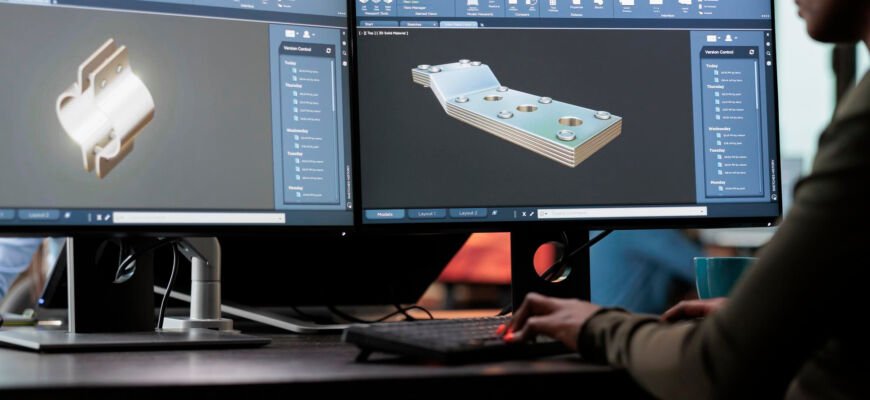SolidWorks, a leader in computer-aided design (CAD) software, plays an important role in solving complex engineering problems in various industries. Known for its reliable functionality and intuitive interface, SolidWorks offers engineers the tools they need to create accurate, detailed models and simulations. In this article, we will look at how SolidWorks Software uses its capabilities to solve the most complex engineering problems, paying special attention to the extensive set of tools and how these tools promote innovation and efficiency.
Comprehensive modeling capabilities
3D design and visualization
SolidWorks occupies a special place in the field of 3D CAD thanks to its powerful design and visualization capabilities. Engineers can create complex geometric figures with high accuracy, which is very important for such industries as aerospace, automotive and industrial industries. The software's ability to provide detailed visualizations helps teams better understand potential problems and iterate projects more effectively.
Improved surfacing
Advanced welding tools in SolidWorks allow engineers to process complex shapes and contours typical of consumer goods and high-performance parts. These tools are invaluable when designing ergonomic interfaces and aerodynamic components, where accuracy and detailing are of paramount importance.
Modeling and analysis tools
SolidWorks Simulation
SolidWorks Simulation is a reliable set of analytical tools that is easily integrated into the SolidWorks software environment, providing engineers and designers with powerful capabilities for advanced modeling. With the help of this tool, users can check the characteristics of products in real conditions, which helps to optimize the design, improve quality and stimulate innovation without the need to create expensive and time-consuming physical prototypes. Below, we'll take a closer look at the features of SolidWorks Simulation and how they can help you in the design process.
Key features of SolidWorks Simulation
1. Finite element analysis (FEA)
SolidWorks Simulation uses finite element analysis to predict the product's response to physical influences, such as vibration, heat, fluid flow, and other physical effects. FEA divides the model into a mesh of finite elements, allowing to analyze the response of the structure to stress and deformation, which guarantees that the product will withstand the intended use.
2. The analysis is tense
Stress analysis tools in SolidWorks Simulation help identify critical stress points in the product before production begins. Applying forces, pressures and other constraints to the model, the program predicts places of deformation and potential failures, allowing engineers to make the necessary changes to increase durability and safety.
3. Dynamic analysis
This function allows you to study the behavior of parts or assemblies under conditions that change over time, including the effects of loads, displaced and accelerated. Dynamic analysis is crucial for evaluating the characteristics of components in motion and can help in the development of more reliable products.
4. Thermal analysis
SolidWorks Simulation allows you to conduct a thermal analysis to study the temperature distribution inside the structure. This is especially important for components and assemblies exposed to heat sources or changing environmental conditions. Thermal analysis helps to optimize heat dissipation, prevent overheating and ensure long-term reliability.
5. Fatigue analysis
Fatigue analysis makes it possible to predict the service life of the product under repeated loads. It helps to determine how long the product will last, subject to cyclic loads, and allows you to choose suitable materials and determine the need for additional reinforcements.
6. Optimization analysis
SolidWorks Simulation includes tools for optimization analysis that allow you to adjust the dimensions and parameters of the structure to meet certain performance criteria. This function helps to minimize weight, reduce the amount of materials, or increase productivity within given constraints.
Benefits of using SolidWorks Simulation
Cost reduction: Modeling and testing at the design stage allows you to identify and solve potential problems at an early stage, which significantly reduces the costs associated with the creation of physical prototypes and tests.
Time efficiency: Acceleration of the product development process due to rapid iteration and design verification with the help of modeling, which accelerates time to market.
Improving quality and innovation: Modeling in SolidWorks provides the insights needed to improve production quality and safely implement innovations. Understanding how structures work in different conditions allows you to confidently implement innovations.
Making informed decisions: Thanks to a detailed understanding of how structures will work, engineers can make more informed decisions, improving the overall design and functionality of the product.
Integration and accessibility
SolidWorks Simulation is fully integrated into the SolidWorks interface, which makes it accessible even to users who are not experts in the field of finite element analysis. The integration ensures that all simulations will be directly applied to the designed 3D models, providing a smooth workflow and immediate feedback when choosing a design.
Modeling of flows
For projects involving liquids and gases, SolidWorks Flow Simulation is an essential tool. It allows engineers to analyze hydrodynamics within a project, optimizing everything from water supply systems to car aerodynamics. This possibility not only increases the productivity of products, but also ensures compliance with regulatory requirements and safety.
Modeling of plastics
SolidWorks also includes specialized tools for modeling the molding of plastic parts under pressure. Engineers can predict how plastic will fill molds and cool, adjusting designs to prevent defects and ensure component manufacturability.
Data management and collaboration
SolidWorks PDM
Effective management of project data is crucial, especially for large-scale projects. The SolidWorks Product Data Management (PDM) system helps teams manage and track design data at various stages of the product development life cycle. PDM systems provide access to all team members to the most up-to-date files, promoting a coordinated and synchronized work process.
eDrawings Professional
Collaboration is simplified thanks to eDrawings Professional, a tool that allows you to easily share SolidWorks files and view them. Stakeholders can make notes and provide feedback directly on the digital models, which improves communication and speeds up review cycles regardless of their location.
Personalization and automation
Macros and API
SolidWorks allows you to significantly expand the possibilities of customization with the help of macros and an application programming interface (API). Engineers can automate repetitive tasks, adapt SolidWorks to unique project needs, and increase productivity by paying more attention to design refinement and less to routine processes.
Custom tools and add-ons
The flexibility of SolidWorks is also confirmed by the support of third-party add-ons and the possibility of developing your own tools within the software. Such adaptability makes it an ideal solution for niche applications and specialized engineering requirements. Next, you will learn with which platforms the software integrates, how and where it is possible Buy Solidworks.
Integration with other tools and platforms
3D Interconnect
The 3D Interconnect function expands the possibilities of working in the environment of several CADs, providing unhindered data exchange and joint work. This is especially important for complex engineering projects that require the integration of components developed using various programs.
Compatibility with developing technologies
The software keeps pace with technological progress, supporting integration with 3D printing and virtual reality (VR). These technologies allow engineers to quickly prototype and test projects in exciting environments, expanding the boundaries of innovation.
Examples from real practice
In various industries - from automotive to electronics - companies use SolidWorks to effectively solve complex engineering problems. For example, car manufacturers used SolidWorks Software to optimize the design of engine components in order to increase its performance and reduce harmful emissions, which clearly demonstrates the ability of software to have a significant impact on product development.
SolidWorks continues to be an important tool for solving complex engineering problems, offering a set of sophisticated features that improve design, analysis and collaboration. If you want to purchase the latest version of SolidWorks Premium or download the previous version, for example, SolidWorks 2020 or 2023, suppliers such as Allsoft Ukraine offer professional licensing solutions. Interested specialists can visit the Allsoft Ukraine online store at https://allsoft.ua/ and explore options for acquisition, secured access to one of the most powerful engineering tools available today. Such investments not only increase individual opportunities, but also contribute to the successful completion of projects in the conditions of growing competition on the market.




